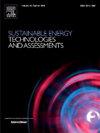使用 SCR 系统减少拖船的氮氧化物排放:AdBlue 的实际影响
IF 7.1
2区 工程技术
Q1 ENERGY & FUELS
Sustainable Energy Technologies and Assessments
Pub Date : 2025-04-01
DOI:10.1016/j.seta.2025.104309
引用次数: 0
摘要
本研究在土耳其Mersin港的拖船上评估了AdBlue注入的选择性催化还原(SCR)系统的实际性能。目的是评估SCR在动态负载条件下减少氮氧化物(NOx)的有效性。在两台主发动机上进行了排放测量:一台SCR不工作(左舷),另一台SCR工作(右舷)。在SCR被动工况下,左舷发动机的平均NOx排放量为654.4 ppm, CO排放量为384.9 ppm。相比之下,scr主动发动机在短途机动和长途机动期间的氮氧化物排放量分别减少了60.1%和50.1%,而CO排放量则增加了83.8%,这表明了NOx - CO的权衡。SCR在稳定负载和最佳排气温度(250-400°C)下表现最佳,而较低的负载会降低其效率,并且需要更多的AdBlue。年氮氧化物排放量从282.47吨(SCR被动)减少到99.31吨(SCR主动-短)和139.83吨(SCR主动-长)。这些结果突出了SCR在海洋应用中的有效性,以及优化AdBlue剂量的重要性。基于实时排气条件的自适应喷射策略可以进一步提高性能并最大限度地减少消耗,支持监管部门为更清洁的港口运营所做的努力。本文章由计算机程序翻译,如有差异,请以英文原文为准。

NOx emission reduction in tugboats with SCR systems: Real-world impact of AdBlue
This study evaluates the real-world performance of a Selective Catalytic Reduction (SCR) system with AdBlue injection on a tugboat operating at Mersin Port, Turkey. The objective was to assess SCR effectiveness in reducing nitrogen oxides (NOx) under dynamic load conditions. Emission measurements were conducted on two main engines: one with SCR inactive (portside) and the other with it active (starboard). Under SCR passive conditions, the portside engine emitted 654.4 ppm NOx and 384.9 ppm CO on average. In contrast, the SCR-active engine achieved NOx reductions of 60.1 % during short maneuvers and 50.1 % during long maneuvers, while CO emissions increased by 83.8 %, indicating the NOx–CO trade-off. SCR performed best under stable loads and optimal exhaust temperatures (250–400 °C), while lower loads reduced its efficiency and required more AdBlue. Annual NOx emissions were reduced from 282.47 tons (SCR passive) to 99.31 tons (SCR active – short) and 139.83 tons (SCR active – long). These results highlight SCR’s effectiveness in marine applications and the importance of optimized AdBlue dosing. Adaptive injection strategies based on real-time exhaust conditions may further improve performance and minimize consumption, supporting regulatory efforts for cleaner port operations.
求助全文
通过发布文献求助,成功后即可免费获取论文全文。
去求助
来源期刊

Sustainable Energy Technologies and Assessments
Energy-Renewable Energy, Sustainability and the Environment
CiteScore
12.70
自引率
12.50%
发文量
1091
期刊介绍:
Encouraging a transition to a sustainable energy future is imperative for our world. Technologies that enable this shift in various sectors like transportation, heating, and power systems are of utmost importance. Sustainable Energy Technologies and Assessments welcomes papers focusing on a range of aspects and levels of technological advancements in energy generation and utilization. The aim is to reduce the negative environmental impact associated with energy production and consumption, spanning from laboratory experiments to real-world applications in the commercial sector.
 求助内容:
求助内容: 应助结果提醒方式:
应助结果提醒方式:


